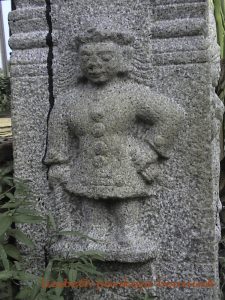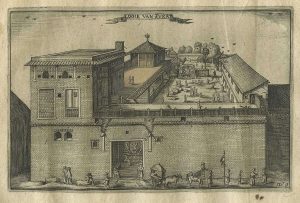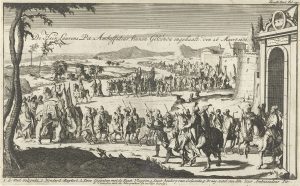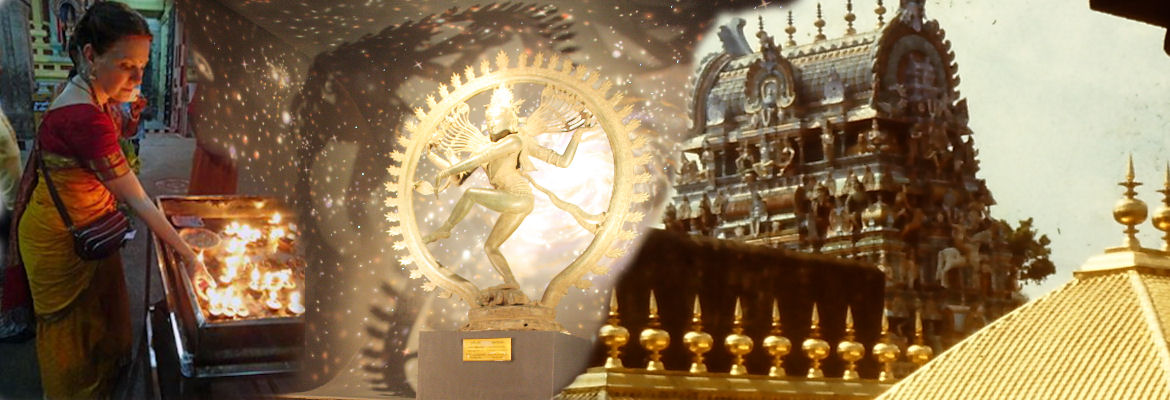
In my previous blog I shared with you my discovery of the identity of the two VOC officers depicted among the relief-portraits of donors on an eclipse mandapam near Sadras and Mahabalipuram on the ECR in Tamil Nadu, India. They are a father and son, Carel Hartsinck (1611-1667) and Willem Carel Hartsinck (1638-1686).
Despised and beloved
A Spanish missionary and archbishop writes about his meeting in 1670 with Willem Carel at the Dutch trading establishment in Golconda.
“I went that Afternoon to see the Dutch Factor, for whom I had a Letter. … It was a long time before I came to the Dutch Factory. Those Men had a fine Palace there, and richly furnish’d. The Factor was a Mungrel begot on a Japonese Woman, and show’d it in his carriage. We discours’d a while with a great deal of coldness on his side…” (The travels and controversies of Friar Domingo Navarette, ed.J.C.Cummins, 1962, vol.II, 1618-1686, p316).
The Spanish archbishop and missionary Domino Navarette didn’t like Willem Carel Hartsinck, chief of the VOC office at Golconda, present day Hyderabad and capitol of the Golconda sultanate, in 1670. The reason behind this dislike are clearly expressed: racism and xenophobia. Friar Domingo calls Hartsinck a ‘Mungrel’, in his travellogue, referring to his half Japanese, half Dutch origin in his travelogue. He much preferred the company of Willem Carel’s colleague. Probably this was the ‘secunde’, second in command, Jan van Nijendaal.
To Daniel Havart, chronographer of events of the Dutch VOC activities on the Coromandel in the latter part of the 17th century, Hartsinck was a beloved benefactor: “My second father you were” Havart wrote reflecting on Willem Carel’s passing “and my benefactor, for over sixteen years: as long as I may break air, your charity, your favor, never leaves from my mind”. (Daniel Havart, Honderd en Vijftig Grafschriften 1718, p162)
Half Dutch, Half Japanese
Willem Carel was born in Firado (today called Hirado), in the prefecture of Nagasaki in Japan on the 12th of July 1638, to Carel Hartsinck, a highly placed VOC officer, and a Japanese mother, variously described as a concubine, a geisha, but also as a woman of high birth. He had an elder brother called Pieter, also born in Firado in 1633. In 1641 Japan ordered all foreigners to leave, at the same time moving the Dutch trading post from Firado to Decima. Japanese wives and half-blood children of VOC employees were exiled to Batavia. The Hartsinck family moved to Batavia in 1641, where the mother died in 1642.

About Willem Carel’s childhood I found contradicting information about which I will share more in my upcoming post about his father Carel Hartsinck. It is sure their father Carel took Willem Carel, and his elder brother Pieter, to Europe and his father’s hometown, Meurs, in what is now the state of North Rhine-Westphalia in Germany. In 1662 Carel legitimized his sons by way of testament. Pieter stayed in Europe, studied at the university in Leiden, and had a career as mathematician and medical doctor in Germany. Father Hartsinck went back to Batavia where became Governor General of the VOC in the East and where he died in 1667.
Daniel Havart writes that a 13-year-old Willem Carel is given a contract as Young Asssistent of the VOC at Surat in Gujarat, India, on the 17th of December 1651. In his “Op en Ondergang van de Cormandel” (Rise and fall of the Cormandel) published in 1693, Volume I, page 170 and further, Havart gives a short biography of his benefactor.
A succesful VOC career
In 1655 Willem Carel is promoted to Assistant, and in 1658 he makes First Assistant. In 1658, he is ensign at the siege of Jaffenapatnam on Ceylon. The general Ryklof van Goens gives him a written testimony and recommendation on this occasion. Between 1660 and 1663 he works and lives at the VOC factory at Daatzerom (Drakshawarama) where he is promoted to Junior Merchant in 1662. Early in 1663 he moves to Golconda (Hyderabad), the capitol of the Sultanate of Golconda. Over time Willem Carel Hartsinck rose through the ranks, makes Merchant in 1665, and Chief Merchant in 1671.
In May 1677 Willem Carel moves to Mazulipatnam on the northern stretch of the Coromandel coast to succeed Pieter Smit, who had died, as Chief merchant. This Pieter Smit was actually Willem Carel’s step-brother. He was the son of Sara de Solemne and Pieter Smit senior. Sara de Solemne became the wife of Carel Hartsinck when she was widowed. They had many, maybe 9 in all, children. All Willem Carel’s half-brothers and -sisters.
On the 29th of June 1677, just three months after the death of her husband, Willem Carel Hartsinck marries Belida van der Laan, the widow of Pieter Smit, in Mazulipatnam.

The Top-Post: governor general of Coromandel
When Jacques Caulier, the Governor General of the VOC on the Coromandel dies in 1679, the post falls to Willem Carel, who was his deputy at that time. In 1681 the post is given to Jacob Joriszn. Pits.
But when his wife Belida dies on 26 October 1682, it seems Willem Carel has had enough of India and the Coromandel. Or did he foresee the great crisis that would envelope the VOC trading in India in the years ahead? Partly due to the warfare between the local kingdoms. And partly due to a restructuring ordered by the VOC Board in Amsterdam. They send Hendrik Adriaen van Reede tot Drakesteyn to India to implement a radical reorganization and restructuring. It was thought this could banish the private trading and other ‘corrupt’ practices. But was with hindsight a ‘penny-wise pound-foolish’ exercise. It actually brought about the end of the so called ‘Golden Age’ of the Republic of the United Netherlands.
On the 13th of October 1685 Willem Carel sets sail from Mazulipatnam to The Netherlands, via Batavia, in the company of Daniel Havart and other confidants. He arrives at ‘t Vlie on the 26th of July 1786.
He settled in Beverwijk where he lived for a few years, till his death on the 22nd of May 1689 aged 50 years, ten months and ten days. He was buried in the local church.
The man and his life as seen in his time
To get get a more detailed idea of the person of Willem Carel Hartsinck, the Dutch-Japanese man who was involved in the project of the eclipse mandapam on the ECR around 1680, we quote what Daniel Havart, Willem Carel’s protégé, wrote about him in his work “De Op en Ondergang van Cormandel”, (The Rise and Fall of Cormandel) published in 1693:
What shall we say of this Mr. Hartsink, as we are not in the position of having sufficient skills, to be able to express one of his least talents, and if we say much, the readers might think, that I had been bribed by promises or gifts, but God, who is aware of everything, also knows, that such is untrue, and that I am one of those, who has no shame to say before the world, that I owe my greatest happiness, rise, and wellbeing to this gentleman, that I have always enjoyed a fatherly friendship by him, and I will continue, and say he was truly a man of great, and stout stature, who understood the Hindustan language thoroughly, who never suppressed anyone, who was a father to the lesser, beneath him; munificent, especially to the poor; talkative, amicable, not lofty, or puffed up, not quickly angered, amenable, stranger of selfishnes, pious in behaviour, and life, carefull in what he did and did not do, the first, and foremost founder of the Golcondan trade, so kindhearted, he even converted his enemies to be his friends, and who would have returned/reinstated the previous magnificence/splendor and respect of the Commerce of the Honorable Company (which had already begun to totter before his time), had he been able to follow his own ideas, but there was one above him, who was of a different sentiment. Whether all the described qualities did not apply to Mr.Hartsink, I leave to the judgement of those, who had the luck, to see him, speak to him, know him, and and then I am confident, that they will say to everything I have written, yes and amen.
In spite of this detailed and positive description of Willem Carel, we are left with many questions. Why and how was Willem Carel involved in thsi astronomical project? The Dutch were at the forefront of science in their 17th century Golden Age. But so far I haven’t found any trace of the eclipse on march 30th 1680, or anything else relating to the mandapa in any Dutch records.
In my next post I will write about Willem Carel’s father, Carel Hartsinck.

Kathleen Ball
Very interesting article
Ejji K. Umamahesh
Excellent article. I have shared the link on my FB page.